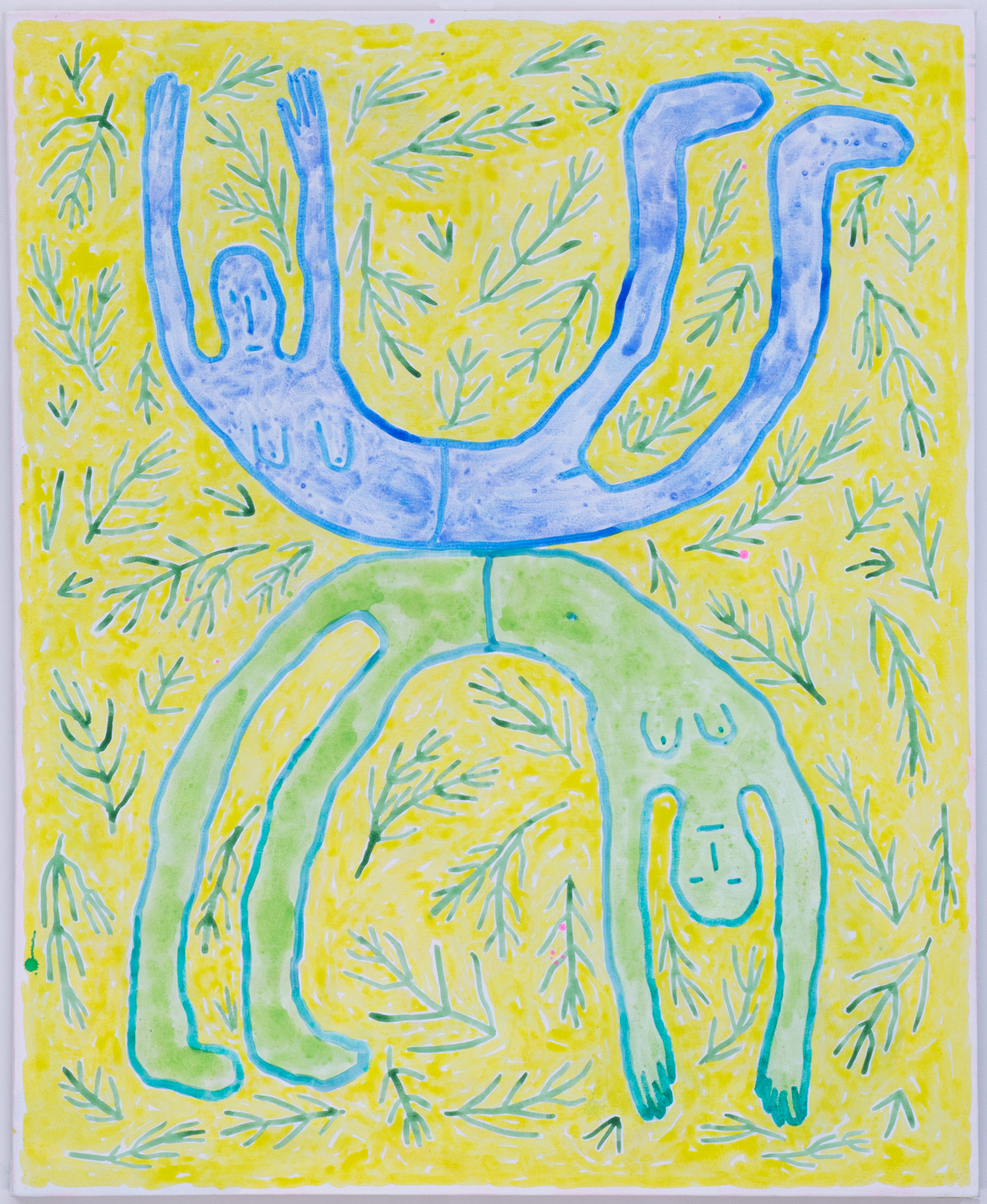Polina Bertou and Jess Perlitz: zero percent contained
November 9 - December 21, 2024What is a container for? For limiting, constraining, hiding away. For protecting, holding, affording safe passage. A body is a container. So is a frame. And with any container comes the specter/inevitability of spillage.
In “zero percent contained,” studio e’s exhibition of work by gallery artist Polina Bertou and Portland artist Jess Perlitz, the container is a site of limitation and possibility. Bertou’s large-scale paintings present figures who arc and contort themselves to fit within the canvas. Yet the palette’s bright yellows and greens, the figures’ curious, peaceful expressions convey the pleasure and wonder one can experience at the edges of their proprioceptive field. Figure and ground are porous, potentializing, indicative of the renewed relationship to the natural world Bertou found while creating this body of work.
Perlitz’s sculptures, on the other hand, expose and subvert the solidity of containers themselves. A 16-foot soft sculpture of an outstretched arm is stuffed with sand, suggesting that it might both hold back a flood and be the flood’s detritus. In another piece, bones hang from the ceiling like bleached-out bunches of bananas, both free of the body and suggesting its structure. While Perlitz’s other, rock-like sculptures suggest a greater sense of solidity, they are porous with holes, messy with dripped paint. Even what seems solid can spill.
Art that refuses containment, or contains curiously, shifts the space of the gallery it stands in, the visitors who approach it. Peer at Bertou’s bodies and feel yourself bending. Eye the hole in Perlitz’s “Faith Rocks” and discover a portal. Don’t fall, says this work, but allow for change. —Sara Jaffe
















Polina Bertou:
Bertou is a painter born in Chelyabinsk, Russia. She moved to Washington in 2002 and now lives in Brooklyn, NY. She earned a BFA in painting and drawing from the University of Washington in 2013, and then an MFA from Hunter College in 2021. Polina has exhibited her work in Germany, New Orleans, New York, Portland, and Seattle. Visually informed by a variety of cultural references encompassing the language of cartooning, painting history, and literature, these works play with a combination of familiar images, scale shifts, and visual and linguistic tropes. Sharp lines live next to loose, expressive brush strokes, chaotic drips, and liquid stains, making the works feel simultaneously like drawings and paintings, equally graphic and abstracted A cast of enigmatic characters in Bertou’s work, figures of humans and animals painted with urgency and speed, peer out of evocative limbos. Stylistically direct, the figures emote vulnerability, anxiety, longing, and other less nameable emotions through subtle gestures and facial expressions. By often painting with bubblegum pinks and stinging neons, Bertou lures the viewer into confronting serious topics through a sense of play. She renders familiar images absurd, presenting an array of humanity that vacillates between hope and despair.
Jess Perlitz:
Perlitz’s work is informed by our formations of landscape and the body’s place within it, finding points of desire, incongruity, and disruption. Born in Toronto, Canada, she is a graduate of Bard College, received an MFA from Tyler School of Art, and clown training from the Manitoulin Center for Creation and Performance. Perlitz is currently based in Portland, Oregon where she is Associate Professor and Head of Sculpture at Lewis & Clark College, and most recently, the co-leader of the year-long Portland’s Monuments & Memorials Project. Perlitz was named a 2019 Hallie Ford Fellow, won a Joan Shipley award, and received an award from the American Academy of Arts and Letters. Her work has appeared in playgrounds, fields, galleries, and museums, including the Institute for Contemporary Art in Philadelphia, Socrates Sculpture Park in NY, Cambridge Galleries in Canada, De Fabriek in The Netherlands, and aboard the Arctic Circle Residency. Her project, Chorus, is currently installed at Eastern State Penitentiary in Philadelphia, PA as part of the museum’s ongoing artists installation series.